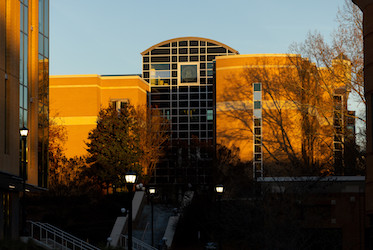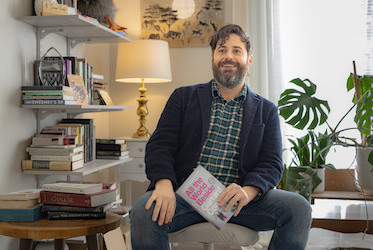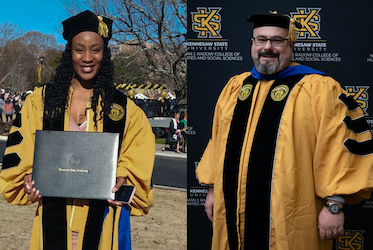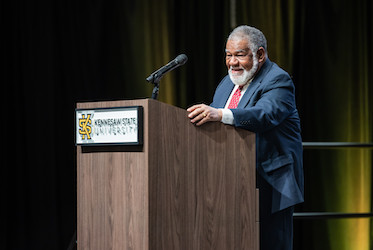
Telling the whole story
KENNESAW, Ga. | Nov 2, 2017
Public history classes help Adairsville bring together pieces of its past
If you love history, antiquing and good food, Georgia’s official tourism website advises, visit Adairsville — “a Norman Rockwell kind of town.”
The site of the Civil War era’s legendary Great Locomotive Chase, Adairsville’s history has centered largely around its role as a transportation hub — halfway between Atlanta and Chattanooga — especially the railroad. Its fabled depot was converted to the Adairsville Rail and Depot Age of Steam Museum in 2001 but closed after 10 years.
Through a partnership between the city, the San Souci Women’s Club and Kennesaw State University’s public history program, a focus on history has returned to the heart of Adairsville. On Sept. 24, the town celebrated the re-opening of the Adairsville Depot History Museum & Welcome Center. A new exhibit in the renovated railroad depot in the town’s public square has attracted more than 3,000 visitors.
Five years ago, when city leaders began envisioning a revitalized public square, they decided that there was so much more history to Adairsville than its railroading past and to all the artifacts and photos that had been assembled. They turned to Jennifer Dickey, associate professor and coordinator of the public history certificate program, to help piece together a more comprehensive story of the town and its people.

Kennesaw State's James Newberry, Jennifer Dickey and Johnny Invansthenko are joined by, from left, Beth Smith and Linda Bass of the Sans Souci Women's Club.
For Dickey, who spent nearly two years meeting with city and civic leaders and conducting research, the prospect of engaging students to help create the new exhibit was nearly as compelling as the town’s storied past and the enthusiasm of its supporters.
The project presented an ideal opportunity for nearly two dozen students in three public history classes to get real-world experience in all aspects of creating a museum exhibit – researching, documenting, curating and creating collaterals materials like a lesson plan and docent guide.
“This was the most the most rewarding community project I’ve ever worked on,” said Dickey, who has worked on a half-dozen such projects during her nine years at Kennesaw State. “Rather than writing the 10-15-page research paper required in upper-level history courses — a paper that only the professor reads — these students have helped produce something that thousands of people will see for a very long time.”
For Brandon Cohran, a senior history major, the experience was “incredibly valuable” to his time at KSU and career goals.
“We worked in groups to research, write text panels, create item labels, and curate the museum’s four different rooms into a cohesive narrative,” said Cohran, who plans to continue working in public history after graduate school. “We had one three-hour class a week, which included several field trips to Adairsville, as well as conducting work at home. It was real-world experience in a museum setting.”
The museum’s new exhibit incorporates many of the long-held artifacts and photographs depicting the town’s rail history but places them in the context of shifts in economic, social, political and cultural life. It presents a more comprehensive history, expanding the narrative of the town and its people.
“We had all these artifacts here that have just sat for so long, but it was just a hodgepodge,” said Linda Bass, a 49-year Adairsville resident and member of the San Souci Women’s Club, which operates the museum. “Adairsville has a rich history and now we have continuity in telling our story.”

Kennesaw State students work at the Adairsville Depot History Museum & Welcome Center.
With the help of Dickey and her students, museum visitors now learn more about some of Adairsville’s famous, infamous and unsung. There’s native son and notorious gangster Charles “Pretty Boy” Floyd; Wally Fowler, the gospel singer who was a member of the group that evolved into the famous Oak Ridge Boys; screen actress Bella Jarret; and William Arthur Butler, the first African-American to open a business in downtown, among others.
Panels convey what happened to the Cherokee Indian tribe that originally inhabited the area — their struggle to hold onto their lands and their eventual forced removal. Also depicted is the town’s diverse agricultural production from cotton and peaches to wheat and flour — and its commercial life, including a cottage chenille bedspread industry that started in people’s homes and grew in factories alongside the area’s textile industry. Woven into all that are stories of 19th and early 20th century community life, including the story of a Boy Scout troop and a women’s club, and artifacts of the period.
Telling those stories began with advance work by Dickey and Johnny Ivansthenko, her graduate research assistant, who laid out the framework for the exhibit, producing research packets to guide students.
“It’s always been a challenge to fit the work of public history into a traditional semester,” said Dickey, “This was a much more comprehensive project involving several classes over two semesters, and we’re still working on it.”
The project began in fall 2016 with students in an oral history class led by James Newberry of Kennesaw State’s Museum of History and Holocaust Education (MHHE). They interviewed seven residents whose stories are woven into the exhibit and captured in a 20-minute video that plays in the museum. Many of those students enrolled along with others in Dickey’s documentation class and a museum education class taught by Richard Harker, former education outreach manager at MHHE in spring 2017. Some are continuing to work on an ongoing series of oral histories.
“Creating a public history exhibit is a process and students were able to experience the entire process from start to finish,” Dickey said. “They gained skills they might use in any museum setting, skills like research and writing, which they can use in whatever they do.”
Ivansthenko, who is working on a master’s in American Studies, says that is exactly what he was hoping for. He majored in education as an undergraduate, with an interest in teaching history.
“It was a huge learning experience and a blessing,” he said. “I wanted to get new experience and develop a new skill set. Now I’d like to continue to do history.”
A Great Partnership
The vision and planning for the museum renovation started with members of Adairsville’s Downtown Development Authority and Historic Preservation Commission, and the Sans Souci Women’s Club.
“We started working on a long-range plan for downtown development, taking a view from 30,000 feet of what could happen there,” said Beth Smith, vice president of the Development Authority and an officer in the San Souci Women’s Club. “The City Council approved the plan and the renovation [of the Depot] was the culmination of it. What we really wanted to achieve was a consistency in the museum’s content so that our 20 volunteers would all have the same information and story. It was a seamless project, and now we have this world-class museum.”
Smith and her committee have been active and hands-on in the process of renovating the museum and helping create the exhibit, identify residents to be interviewed, and helping curate the photos and artifacts.
“They really are a great group of people who are passionate about preserving history,” Dickey said.
History major Cohran agreed, adding, “The most amazing part of the whole project to me was how invited and welcomed we (the KSU students) were by the people who ran the museum.”
# # #
— Sabbaye McGriff
Photos by David Caselli; Videography by Marc Francis
Related Stories
A leader in innovative teaching and learning, Kennesaw State University offers undergraduate, graduate and doctoral degrees to its more than 45,000 students. Kennesaw State is a member of the University System of Georgia with 11 academic colleges. The university’s vibrant campus culture, diverse population, strong global ties and entrepreneurial spirit draw students from throughout the country and the world. Kennesaw State is a Carnegie-designated doctoral research institution (R2), placing it among an elite group of only 7 percent of U.S. colleges and universities with an R1 or R2 status. For more information, visit kennesaw.edu.



















